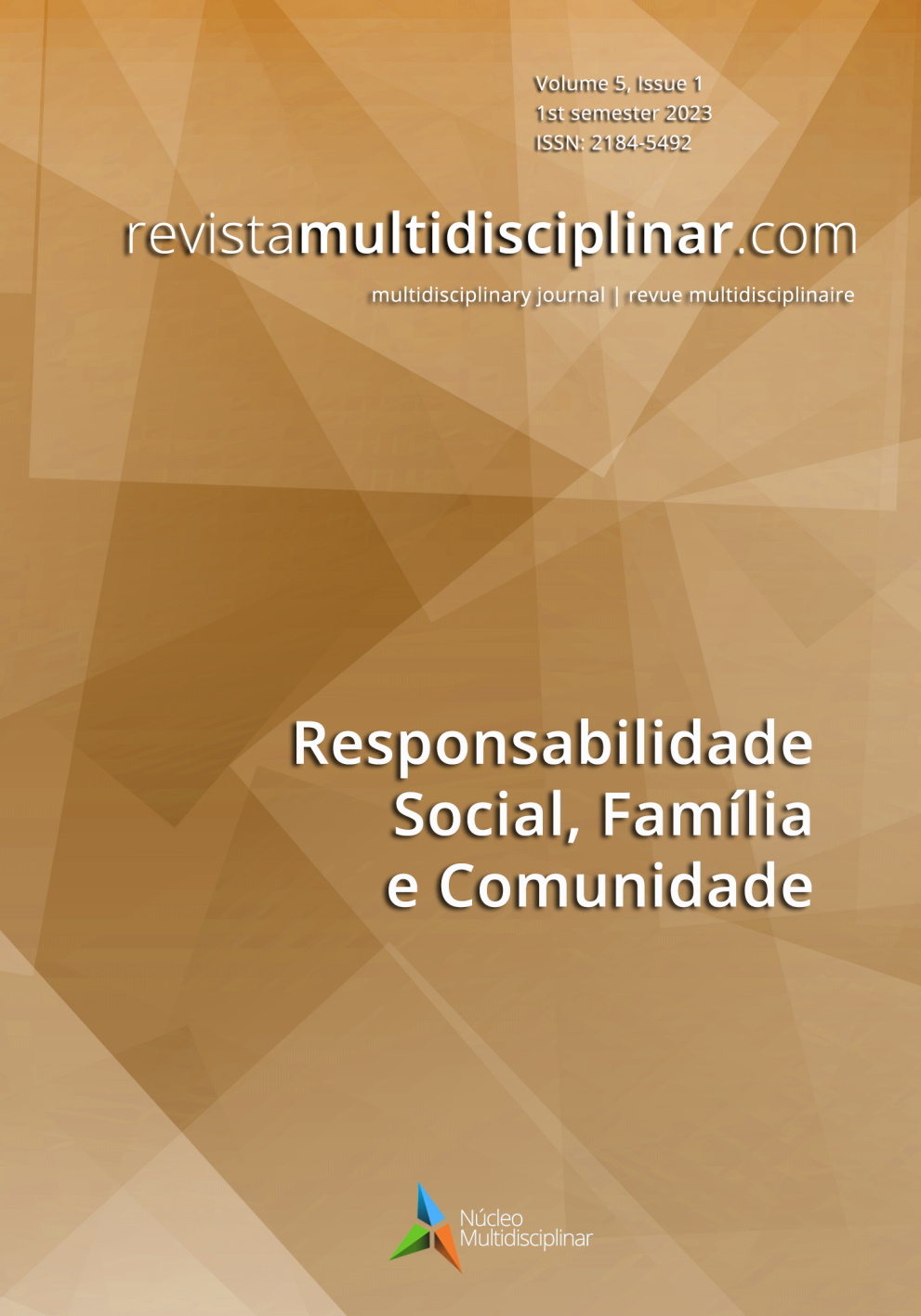Validação do Conduct Disorder Screener entre jovens portugueses
DOI:
https://doi.org/10.23882/rmd.23118Palabras clave:
Português (Portugal)Resumen
A Perturbação do Comportamento (PC) pode estar relacionada com comportamentos de delinquência persistente e severa na adolescência. Pode prolongar-se na idade adulta e ser precursora da Perturbação Antissocial da Personalidade (PAP). Considerando o forte consenso relativamente à necessidade de prevenção e intervenção precoce nos jovens com PC, pelo impacto negativo que estes causam na sociedade, o Conduct Disorder Screener (CDS) pode preencher uma lacuna significativa na obtenção rápida de dados relevantes sobre a PC em adolescentes e dar um importante contributo para a sua investigação no nosso País. O objetivo do presente estudo consistiu na validação do CDS numa amostra total de adolescentes portugueses (N = 601; M idade = 15.95 anos; DP = 1.05 anos; amplitude = 13-18 anos), subdividida em grupo masculino forense, grupo masculino escolar e grupo feminino escolar. A escala demonstrou adequadas características psicométricas, nomeadamente em termos de estrutura fatorial unidimensional, consistência interna por alfa de Cronbach e coeficiente Omega, validade convergente, validade divergente, validade de critério e validade de grupos-conhecidos. Considerando os resultados obtidos, justifica-se a sua utilização em contexto forense e escolar, para identificar PC em adolescentes portugueses.
Citas
Achenbach, T. M. (1991). Manual for the Child Behavior Checklist/4-18. University of Vermont, Department of Psychiatry.
Achenbach, T. M, & Edelbrock, C. S. (1987). Manual for the Youth Self Report and Profile. University of Vermont, Department of Psychiatry.
Achenbach, T. M., Rescorla, L. A., Dias, P., Ramalho, V., Lima, V. S., Machado, B. C., & Gonçalves, M. (2014). Manual do sistema de avaliação empiricamente validado (ASEBA) para o período pré-escolar e escolar: Um sistema integrado de avaliação com múltiplos informadores. Psiquilibrios Edições.
American Psychiatric Association [APA]. (2014). Diagnostic and statistical manual of mental disorder (5ª ed.) (DSM-5) (tradução portuguesa). Climepsi Editores.
Bentler, P., & Wu, E. (2015). Supplement to EQS 6.3 for Windows user’s guide. Multivariate Software, Inc.
Biederman, J., Petty, C., Hughes, S., Mick, E., Monuteaux, M., & Faraone, S. (2008). The long-term longitudinal course of oppositional defiant disorder and conduct disorder in ADHD boys: Findings from a controlled 10-year prospective longitudinal follow-up study. Psychological Medicine, 38(7), 1027-1036. https://doi.org/10.1017/S0033291707002668
Borrajo, R., Gámex-Guadix, M., Pereda, N., & Calvete, E. (2015). The development and validation of the cyber dating abuse questionnaire among young couples. Computers in Human Behavior, 48, 358-365. https://doi.org/10.1016/j.chb.2015.01.063
Braga, T., Pechorro, P., Jesus, S., & Gonçalves, R. (2018). Autoestima, narcisismo e dimensões de delinquência juvenil: Que relação? Análise Psicológica, 36(2), 145-157. https://doi.org/10.14417/ap.1361
Burke, J. D., Pardini, D. A., & Loeber, R. (2008). Reciprocal relationships between parenting behavior and disruptive psychopathology from childhood through adolescence. Journal of Abnormal Child Psychology, 36(5), 679-692. https://doi.org/10.1007/s10802-008-9219-7
Byrne, B. (2006). Structural equation modeling with EQS: Basic concepts, applications, and programming. Lawrence Erlbaum Associates.
Dandreaux, D. M., & Frick, P. J. (2009). Developmental pathways to conduct problems: A further test of the childhood and adolescent-onset distinction. Journal of Abnormal Child Psychology, 37(3), 375-385. https://doi.org/10.1007/s10802008-9261-5
Duarte, V. (2012). Discursos e percursos na delinquência juvenil feminina. Edições Húmus, Lda.
Dunn, T., Baguley, T., & Brunsden, V. (2014). From alpha to omega: A practical solution to the pervasive problem of internal consistency estimation. British Journal of Psychology, 105(3), 399-412. https://doi.org/10.1111/bjop.12046
Farrington, D. P. (2005). Childhood origins of antisocial behavior. Clinical Psychology & Psychotherapy, 12(3), 177-190. https://doi.org/10.1002/cpp.448
Ferguson, C. J. (2009). An effect size primer: A guide for clinicians and researchers. Professional Psychology: Research and Practice, 40(5), 532-538. https://doi.org/10.1037/a0015808
Frick, P. J., & Moffitt, T. E. (2010). A proposal to the DSM-5 childhood disorders and the ADHD and disruptive behavior disorders work groups to include a specifier to the diagnosis of conduct disorder based on the presence of callous-unemotional traits. American Psychiatric Association.
Frick, P., & Viding, E. (2009). Antissocial behaviour from a developmental psychopathology perspective. Development and Psychopathology, 21(4), 1111-1131. https://doi.org/10.1017/S0954579409990071
Gudjonsson, G. H., Sigurdsson, J. F., Sigfusdottir, I. D., & Young, S. (2014). A national epidemiological study of offending and its relationship with ADHD symptoms and associated risk factors. Journal of attention Disorders, 18(1), 3-13. https://doi.org/10.1177/1087054712437584
Hambleton, R. K., Merenda, P. F., & Spielberger, C. D. (2005). Adapting educational and psychological tests for cross-cultural assessment. Lawrence Erlbaum Associates.
Hawkins, D., Laub, J., & Lauritsen, J. (1998). Race, ethnicity, and serious juvenile offending. In R. Loeber & D. Farrington (Eds.), Serious and violent juvenile offenders: Risk factors and successful interventions (pp. 30-46). Sage Publications.
Hutchings, J., Bywater, T., & Daley, D. (2007). Early prevention of conduct disorder: How and why did the North West Wales Sure Start study work? Journal of Children’s Services, 2(2), 4-14. https://doi.org/10.1108/17466660200700012
Imaginário, S., Jesus, S. N., Morais, F., Fernandes, C., Santos, R., Santos, J., & Azevedo, I. (2014). Motivação para a aprendizagem escolar: Adaptação de um instrumento de avaliação para o contexto português. Revista Lusófona de Educação, 27, 91-105.
Jesus, S. N. (2008). Estratégias para motivar os alunos. Educação, 31(1), 21-29.
Jonason, P. K., & Webster, G. D. (2010). The Dirty Dozen: A concise measure of the dark triad. Psychological Assessment, 22(2), 420-432. https://doi.org/10.1037/a0019265
Kaplan, R. M., & Saccuzzo, D. P. (2013). Psychological testing: Principles, applications, & issues (8th ed.). Wadsworth, Cengage Learning.
Lang, J. M., & Connell, C. M. (2017). Development and validation of a brief trauma screening measure for children: The Child Trauma Screen. Psychological Trauma: Theory, Research, Practice, and Policy, 9(3), 390-398. https://doi.org/10.1037/tra0000235
Lewinsohn, P. M., Rohde, P., & Farrington, D. P. (2000). The OADP-CDS: A brief screener for adolescent condut disorder. Journal of the American Academy of Child & Adolescent Psychiatry, 39(7), 888-895. https://doi.org/10.1097/00004583-200007000-00018
Loeber, R., & Farrington, D. P. (1998). Serious and violent juvenile offenders: Risk factors and successful interventions. Sage Publications.
López-Romero, L., Romero, E., & Andershed, H. (2015). Conduct problems in childhood and adolescence: Developmental trajectories, predictors and outcomes in a six-year follow up. Child Psychiatry and Human Development, 46(5), 762-773. https://doi.org/10.1007/s10578-014-0518-7
Mann, M. J., Kristjansson, A. L., Smith, M. L., & Sigfusdottir, I. D. (2016). The influence of negative life events and problem behavior on grades in early adolescence: Pathways to academic risk in the middle grades. Research in Middle Level Education, 39(10), 1-13. https://doi.org/10.1080/19404476.2016.1244402
Marôco, J. (2014). Análise de equações estruturais: Fundamentos teóricos, software & aplicações. ReportNumber, Lda.
Marôco, J. (2018). Análise estatística com o SPSS Statistics (7ª ed.). ReportNumber, Lda.
Nunnally, J., & Bernstein, I. (1994). Psychometric theory (3rd ed.). New York, NY: McGraw-Hill.
Ogilvie, C. A., Newman, E., Todd, L., & Peck, D. (2014). Attachment & violent offending: A meta-analysis. Aggression and Violent Behavior, 19(4), 322-339. https://doi.org/10.1016/j.avb.2014.04.007
Pacheco, J. T. B., & Hutz, C. S. (2009). Variáveis familiares preditoras do comportamento anti-social em adolescentes autores de atos infracionais. Psicologia: Teoria e Pesquisa, 25(2), 213-219. https://doi.org/10.1590/S0102-37722009000200009
Palma, V. H., Pechorro, P., Nunes, C., & Jesus, S. N. (2020). Validação preliminar da versão portuguesa da Child Trauma Screen em adolescentes. Revista Iberoamericana de Diagnóstico y Evaluación - e Avaliação Psicológica, 56(3), 5-19. https://doi.org/10.21865/RIDEP56.3.01
Pechorro, P., Gonçalves, R., Marôco, J., Gama, A., Neves, S., & Nunes, C. (2014). Juvenile delinquency and psychopathic traits: An empirical study with portuguese adolescents. International Journal of Offender Therapy and Comparative Criminology, 58(2), 174-189. https://doi.org/10.1177/0306624X12465584
Pechorro, P., Poiares, C., Marôco, J., & Vieira, R. X. (2012). Traços psicopáticos e perturbação do comportamento em adolescentes institucionalizados. Psicologia, Saúde & Doenças, 13(2), 399-409.
Pechorro, P., Pontes, C., DeLisi, M., Alberto, I., & Simões, M. R. (2018a). Escala breve de autocontrolo: Validação e invariância numa amostra de jovens portugueses. Revista Iberoamericana de Diagnóstico y Evaluación – e Avaliação Psicológica.
Pechorro, P., Russel, J. D., Nunes, L. A., & Nunes, C. (2018b). The Brief Peer Conflict Scale (PCS-20): Psychometric properties among a sample of incarcerated male juvenile offenders. International Journal of Offender Therapy and Comparative Criminology, 62(8), 2414-2429. https://doi.org/10.1177/0306624X17719299
Pechorro, P., DeLisi, M., Alberto, I., Ray, J. V., & Simões, M. R., (2019a). The Triarchic Model of Psychopathy among incarcerated male youths: A psychometric study. In M. DeLisi (Edit.), Routledge international handbook of psychopathy and crime (pp. 265-275). Routledge.
Pechorro, P., Moreira, K., Basto-Pereira, M., Oliveira, J. P., & Ray, J. V. (2019b). The self-report delinquency scale from the national longitudinal study of adolescent to adult health among at-risk for delinquency youths. Violence and Victims, 34(1), 120-135. https://doi.org/10.1891/0886-6708.34.1.120
Pechorro, P., Jonason, P. K., Raposo, V., & Marôco, J. (2019c). Dirty Dozen: A concise measure of Dark Triad traits among at-risk youths. Current Psychology. https://doi.org/10.1007/s12144-019-00288-9
Pechorro, P., Revilla, R., Palma, V. H., Nunes, C., Martins, C., & Cyders, M. A. (2021). Examination of the SUPPS-P Impulsive Behavior Scale among male and female Portuguese youth: Psychometrics and invariance. Children, 8, 283. https://doi.org/10.3390/children8040283
Kratzer, L., & Hodgins, S. (1997). Adult outcomes of child conduct problems: A cohort study. Journal of Abnormal Child Psychology, 25(1), 65-81. https://doi.org/10.1023/A:1025711525255
Rammstedt, B., & Beierlein, C. (2014). Can’t we make it any shorter? The limits of personality assessment and ways to overcome them. Journal of Individual Differences, 35, 212-220. https://doi.org/10.1027/1614-0001/a000141
Resko, S. M., Reddock, E. C., Ranney, M. L., Quyen, E. N., Zimmerman, M. A., Cunningham, R. M., & Walton, M. A. (2016). Reasons for fighting among violent female adolescents: A qualitative investigation from an urban, midwestern community. Social Work in Public Health, 31(3), 99-112. https://doi.org/10.1080/19371918.2015.1087914
Rijo, D., Brazão, N., Silva, D. R., & Vagos, P. (2017). Jovens agressores. Pactor.
Rohde, P., Lewinsohn, P. M., & Seeley, J. R. (1991). Comorbidity of unipolar depression: II. Comorbidity with other mental disorders in adolescents and adults. Journal of Abnormal Psychology, 100(2), 214-222. https://doi.org/10.1037/0021-843X.100.2.205
Rohde, P., Lewinsohn, P. M., & Seeley, J. R. (1997). Comparability of telephone and face-to-face interviews assessing axis I and II disorders. American Journal of Psychiatry, 154(11),1593-1598. https://doi.org/10.1176/ajp.154.11.1593
Russell, J. D. (2014). The Structure of Child and Adolescent Aggression: Confirmatory factor analysis of a Brief Peer Conflict Scale. Thesis Master of Science in Applied Developmental Psychology. University of New Orleans, New Orleans, LA. Retrieved from http://scholarworks.uno.edu/td/1892
Scheepers, F., Buitelaar, J., & Matthys, W. (2011). Conduct disorder and the specifier callous and unemotional traits in the DSM-5. European Child & Adolescent Psychiatry, 20(2), 89-93. https://doi.org/10.1007/s00787-010-0149-x
Sevecke, K., & Kosson, D. (2010). Relationships of child and adolescent psychopathy to other forms of psychopathology. In R. Salekin, & D. Lynam (Eds.), Handbook of child and adolescent psychopathy (pp. 284-314). The Guilford Press.
Simões, C. (2007). Comportamentos de risco na adolescência. Fundação Calouste Gulbenkian.
Simões, M. R. (2000). Investigações no âmbito da Aferição Nacional do Teste das Matrizes Progressivas Coloridas de Raven (MPCR). Fundação Calouste Gulbenkian.
Skilling, T., Quinsey, V., & Craig, W. (2001). Evidence of a taxon underlying serious antisocial behavior in boys. Criminal Justice and Behavior, 28, 450-470. https://doi.org/10.1177/00938548010280040
Tangney, J., Baumeister, R., & Boone, A. (2004). High self-control predicts good adjustment, less pathology, better grades, and interpersonal success. Journal of Personality, 72(2), 271-324. https://doi.org/10.1111/j.0022-3506.2004.00263.x
Udry, J. (2003). The national longitudinal study of Adolescent Health (Add Health), waves I and II, 1994–1996; wave III, 2001–2002. Carolina Population Center, University of North Carolina at Chapel Hill.
Urbina, S. (2014). Essentials of psychological testing (2nd ed.). John Wiley & Sons.
Van Baardewijk, Y., Vermeiren, R., Stegge, H., & Doreleijers, T. (2011). Self-reported psychopathic traits in children: Their stability and concurrent and prospective association with conduct problems and aggression. Journal of Psychopathology and Behavioral Assessment, 33(2), 236-245. https://doi.org/10.1007/s10862-010-9215-4
West, S., Taylor, A., & Wu, W. (2012). Model fit and model selection in structural equation modeling. In R. Hoyle (Ed.), Handbook of structural equation modeling (pp. 209-231). The Guilford Press.
Wolfgang, M. E., Figlio, R., Tracy, P., & Singer, S. I. (1985). The national survey of crime severity. U. S. Government Printing Office.
Young, S., Misch, P., Collins, P., & Gudjonsson, G. (2011). Predictors of institutional behavioural disturbance and offending in the community among young offenders. The Journal of Forensic Psychiatry & Psychology, 22(1), 72-86. https://doi.org/10.1080/14789949.2010.49599
Publicado
Cómo citar
Número
Sección
Licencia
Derechos de autor 2023 Victor Hugo Palma, Pedro Pechorro, Saúl Neves de Jesus, Cristina Nunes

Esta obra está bajo una licencia internacional Creative Commons Atribución-NoComercial 4.0.









